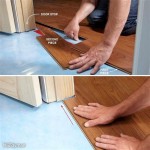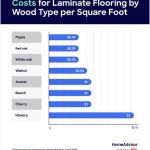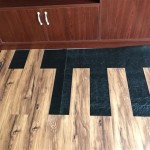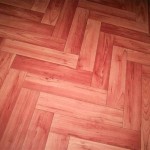Home Depot Rustic Wood Vinyl Flooring: A Comprehensive Guide
Rustic wood vinyl flooring, available at Home Depot and other retailers, offers a compelling alternative to traditional hardwood. It provides the aesthetic appeal of natural wood grain and textures while incorporating the practical benefits of vinyl, such as water resistance and durability. This article explores the characteristics, advantages, installation considerations, and maintenance needs associated with Home Depot's rustic wood vinyl flooring options.
Rustic wood vinyl flooring often features designs that mimic distressed or aged wood. This can include simulated knots, grain variations, and color shading that emulate the look of reclaimed lumber. The vinyl material is typically layered to create a realistic appearance and provide dimensional stability. The top layer is a wear layer that protects the flooring from scratches, dents, and fading. Below this, there is often a decorative layer printed with the wood grain pattern, followed by core layers that provide structural support and cushioning.
Understanding the Benefits of Rustic Wood Vinyl Flooring
One of the primary benefits of rustic wood vinyl flooring is its water resistance. Unlike solid hardwood, vinyl is impervious to water damage, making it a suitable choice for areas prone to moisture, such as bathrooms, kitchens, and basements. This eliminates concerns about warping, swelling, or mold growth, which can be significant issues with natural wood in humid or wet environments.
Durability is another key advantage. The wear layer of vinyl flooring is designed to withstand heavy foot traffic and resist scratches, stains, and dents. This makes it an appropriate option for households with children and pets, as well as high-traffic areas within a home. The robustness of the wear layer is typically measured in mils; a thicker wear layer indicates greater resistance to wear and tear.
Cost-effectiveness is also a noteworthy aspect. Vinyl flooring is generally less expensive than solid hardwood or engineered wood flooring. This can make it an appealing option for homeowners on a budget who want to achieve the look of wood without the high price tag. Installation costs can also be lower, especially for DIY projects, as vinyl flooring is often easier to install than traditional hardwood.
Maintenance requirements are minimal. Vinyl flooring is easy to clean and requires no special treatments or sealants. Regular sweeping or vacuuming is usually sufficient to remove dirt and debris. For deeper cleaning, a damp mop with a mild detergent can be used. Unlike hardwood, vinyl flooring does not need to be sanded, refinished, or waxed.
Exploring Different Types of Rustic Wood Vinyl Flooring at Home Depot
Home Depot typically offers a range of rustic wood vinyl flooring options, including sheet vinyl, vinyl planks, and vinyl tiles. Each type has its own characteristics and installation methods.
Sheet vinyl comes in large rolls and is installed as a single, continuous surface. This minimizes seams and provides excellent water resistance. Sheet vinyl is often a good choice for bathrooms and kitchens where water exposure is a concern. However, installation can be more challenging than with planks or tiles, requiring precise measurements and careful cutting.
Vinyl planks are individual pieces that interlock or adhere to the subfloor. They offer a more realistic wood look compared to sheet vinyl, as the individual planks mimic the appearance of hardwood boards. Vinyl planks are available in various sizes and thicknesses, allowing for different design possibilities. Installation is generally straightforward, making it a popular choice for DIY projects.
Vinyl tiles are similar to planks but are typically square-shaped. They can be used to create unique patterns and designs. Vinyl tiles are also relatively easy to install, although they can be more time-consuming than planks if a complex pattern is desired. Both planks and tiles often feature click-lock systems that allow them to be floated over the subfloor without the need for adhesives.
Within each of these types, Home Depot offers various rustic wood designs. These can range from light, weathered finishes to dark, distressed tones. The texture of the vinyl can also vary, with some products featuring embossed surfaces that mimic the feel of real wood grain. The choice of design will depend on the homeowner's aesthetic preferences and the overall style of the room.
Installation Considerations for Rustic Wood Vinyl Flooring
Proper subfloor preparation is crucial for a successful vinyl flooring installation. The subfloor must be clean, level, and dry. Any imperfections, such as cracks or unevenness, should be repaired before installing the vinyl. This may involve patching holes, sanding down high spots, or applying a leveling compound.
For sheet vinyl, precise measurements are essential to ensure a proper fit. The sheet must be carefully cut to size and then glued to the subfloor. Seams should be properly sealed to prevent water penetration. Professional installation is often recommended for sheet vinyl, as it requires specialized tools and expertise.
Vinyl planks and tiles are generally easier to install, especially those with click-lock systems. These products can be floated over the subfloor without the need for adhesives. However, it is important to follow the manufacturer's instructions carefully. The planks or tiles should be properly aligned and interlocked to create a seamless surface. A tapping block and rubber mallet can be used to ensure a tight fit.
When installing vinyl flooring over concrete, it is important to test the moisture content of the concrete. Excessive moisture can damage the vinyl and lead to mold growth. A moisture barrier may be required to prevent moisture from migrating through the concrete and affecting the flooring.
Acclimation is also an important factor. Vinyl flooring should be acclimated to the room temperature for at least 48 hours before installation. This allows the material to adjust to the environment and prevents expansion or contraction after installation.
Maintenance and Care of Rustic Wood Vinyl Flooring
Maintaining rustic wood vinyl flooring is relatively simple. Regular sweeping or vacuuming is sufficient to remove dirt, dust, and debris. A soft-bristled broom or a vacuum cleaner with a floor brush attachment should be used to avoid scratching the surface.
For spills and stains, a damp cloth or mop with warm water and a mild detergent should be used. Avoid using abrasive cleaners or scouring pads, as these can damage the wear layer. The manufacturer's recommendations should be consulted for specific cleaning products.
To prevent scratches and dents, furniture legs should be fitted with felt pads. Heavy objects should be lifted rather than dragged across the floor. Area rugs can be used in high-traffic areas to protect the vinyl from wear and tear.
While vinyl flooring is water-resistant, it is still important to clean up spills promptly. Prolonged exposure to water can cause discoloration or damage to the subfloor. Any standing water should be wiped up immediately.
Avoid using excessive amounts of water when mopping the floor. A damp mop is sufficient to clean the surface. Excess water can seep into the seams and cause problems over time.
Comparing Rustic Wood Vinyl Flooring with Other Flooring Options
Rustic wood vinyl flooring offers a unique blend of aesthetic appeal and practicality, but it is important to compare it with other flooring options to determine the best choice for a particular application.
Compared to solid hardwood, vinyl flooring is more water-resistant, more durable, and less expensive. However, solid hardwood offers a natural look and feel that cannot be fully replicated by vinyl. Hardwood can also be refinished multiple times, extending its lifespan. Vinyl flooring cannot be refinished.
Compared to engineered wood flooring, vinyl is more water-resistant and less prone to warping. Engineered wood consists of a thin layer of hardwood veneer over a plywood or fiberboard core. While it offers a more natural look than vinyl, it is still susceptible to water damage.
Compared to laminate flooring, vinyl is more water-resistant and more comfortable underfoot. Laminate flooring consists of a printed paper layer over a fiberboard core. While it is less expensive than vinyl, it is also less durable and less resistant to moisture.
Compared to ceramic or porcelain tile, vinyl is warmer and softer underfoot. Tile is extremely durable and water-resistant, but it can be cold and hard. Vinyl is also easier to install than tile, especially for DIY projects.
Considering the Environmental Impact
The environmental impact of vinyl flooring is a factor to consider when making a flooring choice. Traditional vinyl flooring is made from polyvinyl chloride (PVC), a plastic material that is derived from petroleum. The production of PVC can release harmful chemicals into the environment.
However, some manufacturers are now offering more sustainable vinyl flooring options. These products may be made from recycled materials or use alternative plasticizers that are less harmful to the environment. Look for certifications such as FloorScore, which indicates that the product has been tested for low VOC emissions.
The durability and longevity of vinyl flooring can also contribute to its environmental friendliness. By lasting longer than other flooring options, it reduces the need for frequent replacements, which can save resources and reduce waste.
Budgeting for Rustic Wood Vinyl Flooring
The cost of rustic wood vinyl flooring can vary depending on the type of vinyl, the thickness of the wear layer, the design, and the installation method. Sheet vinyl is generally the least expensive option, while vinyl planks and tiles can be more costly.
In addition to the cost of the flooring itself, it is important to factor in the cost of installation. Professional installation can add significantly to the overall cost, especially for sheet vinyl. DIY installation can save money, but it requires time, effort, and the right tools.
Other costs to consider include subfloor preparation, adhesives (if needed), and any necessary trim or moldings. It is also wise to set aside a contingency fund for unexpected expenses.

Lifeproof Rustic Wood 6 Mil X 8 7 In W 48 L Lock Waterproof Luxury Vinyl Plank Flooring 20 06 Sqft Case I969102l The Home Depot

Malibu Wide Plank Hickory Angel Island 20 Mil 9 1 In X 60 Lock Waterproof Luxury Vinyl Flooring 461 6 Sq Ft Pallet Hdmucl234rcpl The Home Depot

Islander Natural Burlap 20 Mil X 9 1 In W 48 L Lock Waterproof Luxury Vinyl Plank Flooring 15 2 Sqft Case 811062 The Home Depot

Have A Question About Trafficmaster Rustic Taupe Residential Vinyl Sheet Flooring 12 Ft Wide X Cut To Length Pg 4 The Home Depot

Acqua Floors Rustic Boat House 12 Mil X 7 2 In W 48 L Lock Waterproof Luxury Vinyl Plank Flooring 24 Sqft Case Af70006 The Home Depot

A Surfaces Rustic Pecan 12 Mil X 7 In 48 Waterproof Lock Luxury Vinyl Plank Flooring 1307 35 Sq Ft Pallet Lvr5012 0011 The Home Depot

Lifeproof Red Rosewood Wood Residential Light Commercial Vinyl Sheet Flooring 12ft Wide X Cut To Length U9790537c832l14 The Home Depot

A Surfaces Rustic Pecan 12 Mil X 9 In 60 Waterproof Lock Luxury Vinyl Plank Flooring 22 44 Sq Ft Case Hd Lvr5012 0121 The Home Depot

Pergo Outlast Golden Rustic Oak 12 Mm T X 6 1 In W Waterproof Laminate Wood Flooring 16 Sqft Case Lf000985 The Home Depot

Reviews For A Surfaces Rustic Pecan 20 Mil X 9 In 60 Waterproof Lock Luxury Vinyl Plank Flooring 48 Cases 897 6 Sq Ft Pallet Pg 5 The Home Depot
Related Posts








